触发器简介:
触发器是一种特殊的存储过程,它的执行不是由程序调用,也不是手动执行,而是由事件来触发。触发器是当对某一个表进行操作。例如:update、insert、delete这些操作的时候,系统会自动调用执行该表上对应的触发器。
触发器分类:
1、DML( 数据操纵语言 Data Manipulation Language)触发器:是指触发器在数据库中发生 DML 事件时将启用。DML事件是指在表或视图中对数据进行的 insert、update、delete 操作的语句。
2、DDL(数据定义语言 Data Definition Language)触发器:是指当服务器或数据库中发生 DDL 事件时将启用。DDL事件是指在表或索引中的 create、alter、drop 操作语句。
3、登陆触发器:是指当用户登录 SQL SERVER 实例建立会话时触发。如果身份验证失败,登录触发器不会触发。
其中 DML 触发器比较常用,根据 DML 触发器触发的方式不同又分为以下两种情况:
after 触发器(之后触发):其中 after 触发器要求只有执行 insert、update、delete 某一操作之后触发器才会被触发,且只能定义在表上。
instead of 触发器 (之前触发):instead of 触发器并不执行其定义的操作(insert、update、delete)而仅是执行触发器本身。可以在表或视图上定义 instead of 触发器。
DML
触发器有两个特殊的表:插入表(instered)和删除表(deleted),这两张表是逻辑表。这两个表是建立在数据库服务器的内存中,而且两张表的都是只读的。这两张表的结构和触发器所在的数据表的结构是一样的。当触发器完成工作后,这两张表就会被删除。Inserted
表的数据是插入或是修改后的数据,而 deleted 表的数据是更新前的或是已删除的数据。
AFTER 触发器语法:
1 CREATE [ OR ALTER ] TRIGGER [ schema_name . ]trigger_name
2 ON { table }
3 [ WITH
4 { FOR | AFTER }
5 { [ INSERT ] [ , ] [ UPDATE ] [ , ] [ DELETE ] }
6 AS { sql_statement [ ; ] [ ,…n ] }
7
8
9 [ NATIVE_COMPILATION ]
10 [ SCHEMABINDING ]
11 [ EXECUTE AS Clause ]
INSTEAD OF 触发器语法:
1 CREATE [ OR ALTER ] TRIGGER [ schema_name . ]trigger_name
2 ON { table | view }
3 [ WITH
4 { FOR | AFTER | INSTEAD OF }
5 { [ INSERT ] [ , ] [ UPDATE ] [ , ] [ DELETE ] }
6 [ WITH APPEND ]
7 [ NOT FOR REPLICATION ]
8 AS { sql_statement [ ; ] [ ,…n ] | EXTERNAL NAME
9
10
11 [ ENCRYPTION ]
12 [ EXECUTE AS Clause ]
13
14
15 assembly_name.class_name.method_name
DDL 触发器语法:
1 CREATE [ OR ALTER ] TRIGGER trigger_name
2 ON { ALL SERVER | DATABASE }
3 [ WITH
4 { FOR | AFTER } { event_type | event_group } [ ,…n ]
5 AS { sql_statement [ ; ] [ ,…n ] | EXTERNAL NAME < method specifier > [ ; ] }
6
7
8 [ ENCRYPTION ]
9 [ EXECUTE AS Clause ]
登陆触发器语法:
1 CREATE [ OR ALTER ] TRIGGER trigger_name
2 ON ALL SERVER
3 [ WITH
4 { FOR| AFTER } LOGON
5 AS { sql_statement [ ; ] [ ,…n ] | EXTERNAL NAME < method specifier > [ ; ] }
6
7
8 [ ENCRYPTION ]
9 [ EXECUTE AS Clause ]
参数:
CREATE OR ALTER:
创建或者有条件的修改触发器(即要修改的触发器必须已经存在)。
schema_name:
DML触发器所属的模式的名称(即所有者,例如:dbo)。
trigger_name:
是触发器的名称。
table | view:
是执行 DML 触发器的表或视图,有时称为触发器表或触发器视图。指定表格或视图的完全限定名称是可选的。视图只能由 INSTEAD OF 触发器引用。
DATABASE:
将 DDL 触发器的范围应用于当前数据库。如果指定,触发器会在当前数据库中发生 event_type 或 event_group 时触发。
ALL SERVER:
将 DDL 或登录触发器的作用域应用于当前服务器。如果指定,触发器会在当前服务器的任何地方发生 event_type 或 event_group 时触发。
WITH ENCRYPTION:
加密 CREATE TRIGGER 语句的文本。使用 WITH ENCRYPTION 可以防止触发器作为 SQL Server 复制的一部分进行发布。无法为 CLR 触发器指定 WITH ENCRYPTION。
EXECUTE AS:
指定执行触发器的安全上下文。以便能够控制 SQL Server 实例用于验证触发器引用的任何数据库对象的权限的用户帐户。
NATIVE_COMPILATION:
表示触发器是本地编译的。
SCHEMABINDING:
指定触发器引用的表不能被删除或更改。
FOR | AFTER:
AFTER 指定仅在触发 SQL 语句中指定的所有操作成功执行时触发 DML 触发器。所有引用级联操作和约束检查在此触发器触发之前也必须成功。当 FOR 是指定的唯一关键字时,AFTER 是默认值。视图无法定义AFTER触发器。
INSTEAD OF:
指定执行 DML 触发器而不是触发 SQL 语句,因此覆盖触发语句的操作。无法为 DDL 或登录触发器指定 INSTEAD OF。
对于 INSTEAD OF 触发器,在具有指定级联动作 ON DELETE 的引用关系的表上不允许使用 DELETE 选项。类似地,在具有指定级联动作 ON UPDATE 的引用关系的表上,不允许 UPDATE 选项。
{[DELETE] [,] [INSERT] [,] [UPDATE]} :
指定在针对此表或视图进行尝试时激活 DML 触发器的数据修改语句。必须至少指定一个选项。在触发器定义中允许以任何顺序对这些选项进行任意组合。
event_type:
是执行后导致 DDL 触发器触发的 Transact-SQL 语言事件的名称。
event_group:
是 Transact-SQL 语言事件的预定义分组的名称。属于任何 Transact-SQL 语言事件执行后的 DDL 触发器触发 event_group。
sql_statement:
是触发条件和动作。触发条件指定附加条件,以确定尝试的 DML,DDL 或登录事件是否导致执行触发器操作。
对于 CLR 触发器,指定要与触发器绑定的程序集的方法。该方法不得不引用任何参数并返回 void。class_name 必须是有效的 SQL Server 标识符,并且必须作为具有程序集可见性的程序集中的类存在。
以下是DML触发器的使用,先看看示例数据: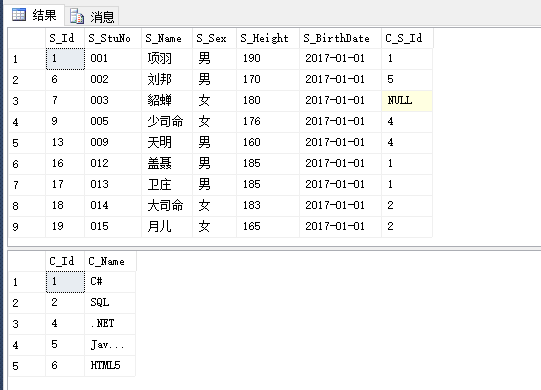
insert 触发器:
1 if(OBJECT_ID(‘trigger_Stu_Insert’) is not null) — 判断名为 trigger_Stu_Insert 的触发器是否存在
2 drop trigger trigger_Stu_Insert — 删除触发器
3 go
4 create trigger trigger_Stu_Insert
5 on Student — 指定创建触发器的表
6 for insert — insert 触发器,也可以写为 after insert
7 as
8
9 declare @C_Id int
10 declare @S_Id int
11
12 select @C_Id=C_Id from Course where C_Name=’SQL’ — 获取课程为 SQL 的ID
13 select @S_Id=S_Id from inserted —插入一条学生的数据,那么这条数据就存在 inserted 这个表中
14
15 select @C_Id
16 select @S_Id
17
18 select from inserted
19
20 update Student set C_S_Id=@C_Id where S_Id=@S_Id
21 go
22
23 insert into Student(S_StuNo,S_Name,S_Sex,S_Height,S_BirthDate)
24 values(‘016’,’大熊’,’男’,’210’,’2017-01-01’)
25
26 select from Student
27 select from Course
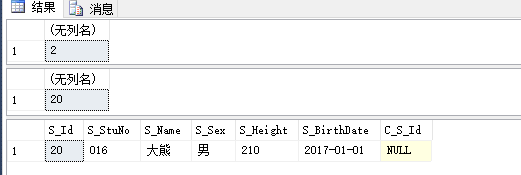
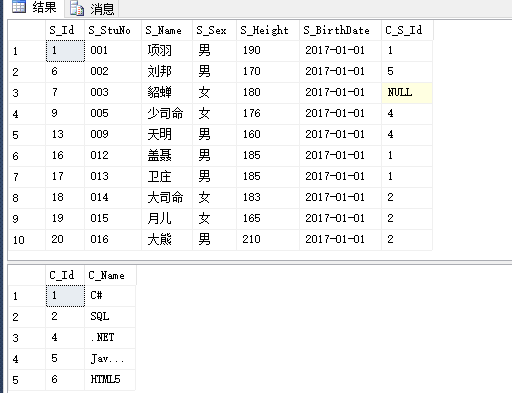
这个例子是:当 Student 表新增一条数据时,修改这条数据的课程ID。
delete 触发器:
1 if(OBJECT_ID(‘trigger_Stu_Delete’) is not null) — 判断名为 trigger_Stu_Delete 的触发器是否存在
2 drop trigger trigger_Stu_Delete — 删除触发器
3 go
4 create trigger trigger_Stu_Delete
5 on Student — 指定创建触发器的表
6 for delete — delete 触发器,也可以写为 after delete
7 as
8
9 declare @C_S_Id int
10
11 select @C_S_Id=C_S_Id from deleted —删除的学生的数据就存在 deleted 这个表中
12
13 select @C_S_Id
14
15 select from deleted
16
17 delete from Course where C_Id=@C_S_Id — 删除具有删除的学生的课程ID的课程
18 go
19
20 delete from Student where C_S_Id=’1’
21
22 select from Student
23 select from Course

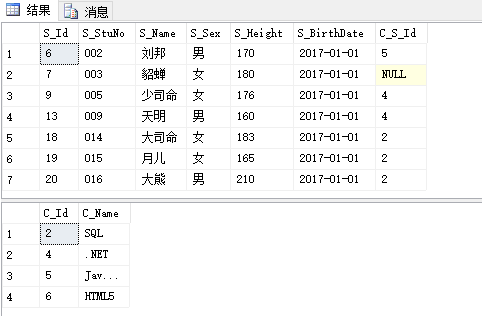
这个例子是:删除指定课程ID的学生时,并删除指定课程ID的课程。
update 触发器:
1 if(OBJECT_ID(‘trigger_Cou_Update’) is not null) — 判断名为 trigger_Cou_Update 的触发器是否存在
2 drop trigger trigger_Cou_Update — 删除触发器
3 go
4 create trigger trigger_Cou_Update
5 on Course — 指定创建触发器的表
6 for update — update 触发器,也可以写为 after update
7 as
8
9 declare @C_Id int
10
11 select @C_Id=C_Id from deleted
12
13 select from deleted — 修改前的数据就存在 deleted 这个表中
14
15 select from inserted — 修改后的数据就存在 inserted 这个表中
16
17 update Student set C_S_Id=@C_Id where C_S_Id is null
18 go
19
20 update Course set C_Name=’C#’ where C_Id=’4’
21
22 select from Student
23 select from Course
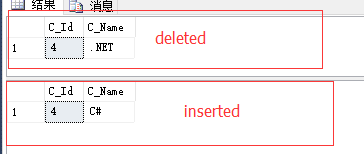

这个例子是:修改课程名称时,把课程ID为空(null)的学生的课程ID默认为修改的课程ID。
禁止修改学生学号触发器,触发器进行数据回滚:
1 if(OBJECT_ID(‘trigger_Stu_Update’) is not null) — 判断名为 trigger_Stu_Update 的触发器是否存在
2 drop trigger trigger_Stu_Update — 删除触发器
3 go
4 create trigger trigger_Stu_Update
5 on Student — 指定创建触发器的表
6 for update — update 触发器,也可以写为 after update
7 as
8 begin try
9 if(UPDATE(S_StuNo)) — 列级触发器:判断是否更新了学生学号(学号不允许更改)
10 begin
11 raiserror(66666,16,1)
12 end
13 end try
14 begin catch
15 select from deleted — 修改前的数据就存在 deleted 这个表中
16 select from inserted — 修改后的数据就存在 inserted 这个表中
17 rollback tran;
18 end catch
19 go
20
21 update Student set S_StuNo=’006’ where S_Id=’20’
22
23 select from Student
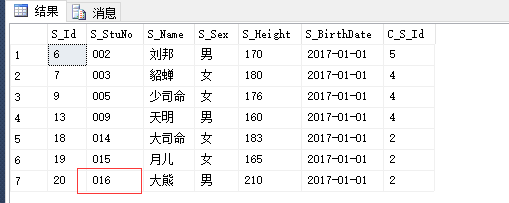
after 触发器可以指定多个操作都可以触发该触发器。只需要在 for/after 后面添加逗号和触发器的类型,例如:
1 for update,insert,delete
2
3 after update,insert,delete
instead of 触发器:
这个触发器就好玩了,下面先看看数据。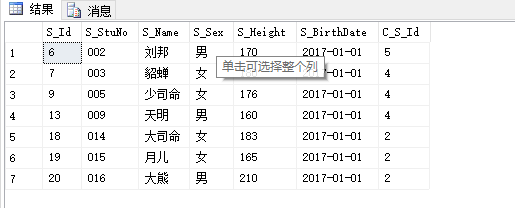

1 if(OBJECT_ID(‘trigger_Stu_InsteadOf’) is not null) — 判断名为 trigger_Stu_InsteadOf 的触发器是否存在
2 drop trigger trigger_Stu_InsteadOf — 删除触发器
3 go
4 create trigger trigger_Stu_InsteadOf
5 on Student — 指定创建触发器的表
6 instead of update,insert,delete — instead of 触发器
7 as
8 select from deleted — 修改前的数据就存在 deleted 这个表中
9 select from inserted — 修改后的数据就存在 inserted 这个表中
10 go
11
12 update Student set S_StuNo=’006’ where S_Id=’20’
13
14 insert into Student([S_StuNo],[S_Name],[S_Sex],[S_Height],[S_BirthDate])
15 values(‘017’,’清红’,’女’,’180’,’2017-01-01’)
16
17 delete from Student where C_S_Id=’5’
18
19 select from Student
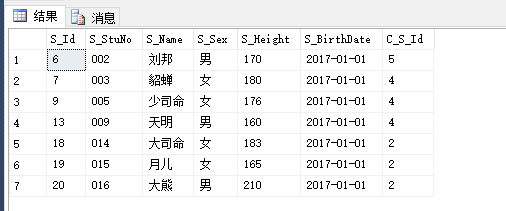
执行上面的语句之后,咦,数据怎么一点变化都没有?看看上面的介绍。instead of 触发器是之前触发。
instead of
触发器并不执行其定义的操作(insert、update、delete)而仅是执行触发器本身,并且会覆盖触发语句的操作,即 after 触发器
T-SQL 语句的操作,很明显我们上面定义的表 Student 的 after 触发器也没有效果了,现在理解了这句话了吧。
修改触发器:
1 alter trigger trigger_Stu_InsteadOf — 修改触发器
2 on Student — 指定创建触发器的表
3 instead of update,insert,delete — instead of 触发器
4 as
5 declare @Count1 int
6 declare @Count2 int
7
8 select @Count1=COUNT(1) from deleted
9 select @Count2=COUNT(1) from inserted
10
11 if(@Count1>0 and @Count2>0)
12 begin
13 select ‘update操作’
14 end
15 else if(@Count1>0)
16 begin
17 select ‘delete操作’
18 end
19 else if(@Count2>0)
20 begin
21 select ‘insert操作’
22 end
23 go
24
25 update Student set S_StuNo=’006’ where S_Id=’20’
26
27 insert into Student([S_StuNo],[S_Name],[S_Sex],[S_Height],[S_BirthDate])
28 values(‘017’,’清红’,’女’,’180’,’2017-01-01’)
29
30 delete from Student where C_S_Id=’5’
31
32 select from Student
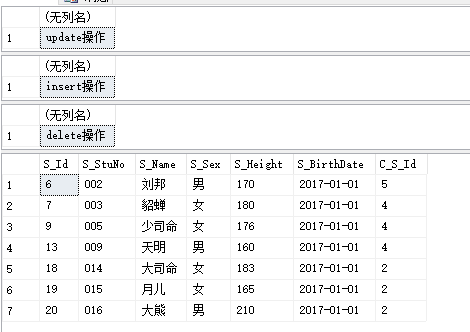
启用/禁用触发器:
1 —禁用触发器
2 disable trigger trigger_Stu_InsteadOf on Student; — trigger_Stu_InsteadOf 触发器名称
3 —启用触发器
4 enable trigger trigger_Stu_InsteadOf on Student; — trigger_Stu_InsteadOf 触发器名称
查询已存在的触发器:
1 — 查询已存在的触发器
2 select from sys.triggers;
3 select from sys.objects where type = ‘TR’;
4 select from sysobjects where xtype=’TR’
1 — sys.trigger_events 触发器事件对象视图
2 select from sys.trigger_events
3
4 — 查看触发器触发事件对象
5 select a.type_desc,b. from sys.trigger_events a
6 inner join sys.triggers b on a.object_id = b.object_id
7 where b.name = ‘trigger_Stu_Insert’;
8
9 — 查询创建触发器的 T-SQL 文本
10 exec sp_helptext ‘trigger_Stu_Insert’
参考:
http://www.cnblogs.com/hoojo/archive/2011/07/20/2111316.html
https://docs.microsoft.com/en-us/sql/t-sql/statements/create-trigger-transact-sql#remarks-dml-triggers

